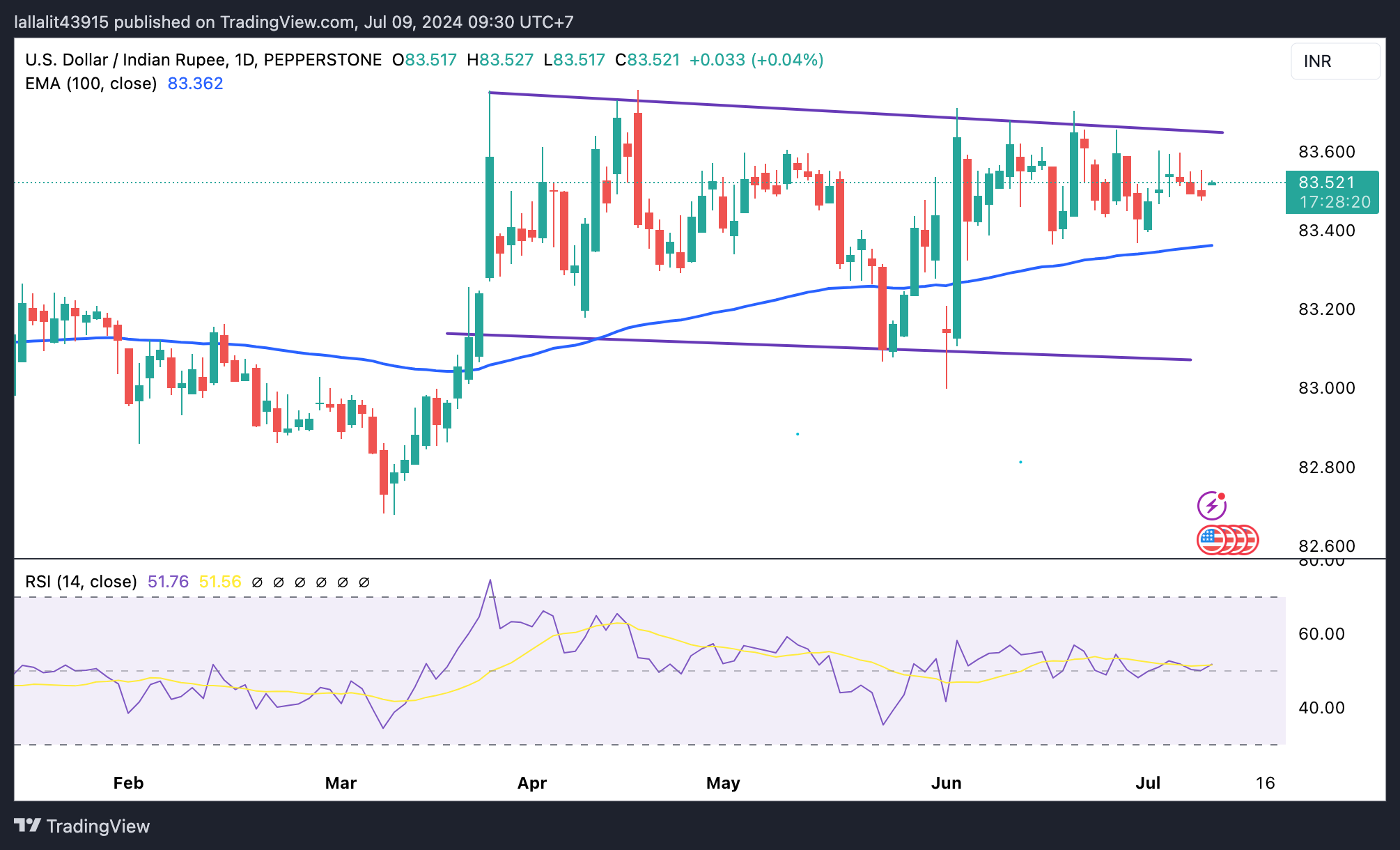USD/INR gains momentum ahead of Fed Powell’s testimony

- The Indian Rupee trades in negative territory on Tuesday.
- The local currency declines on the back of a firmer US Dollar and fears of disruption in US oil supply.
- Investors will closely monitor Fed Chair Jerome Powell’s testimony on Tuesday.
The Indian Rupee (INR) weakens on Tuesday amid the recovery of the Greenback. The local currency loses traction as concerns about tropical storm Beryl disrupting US oil supply weigh on sentiment. However, the rising bets on a September rate cut by the US Federal Reserve (Fed) after US employment data on Friday signaled a cooling US labor market, which might undermine the US Dollar (USD).
The Fed Chairman Jerome Powell’s semi-annual monetary policy testimony to US lawmakers on Tuesday will be closely watched. This event “could be an opportunity for him to share whether the odds of a September rate cut have improved with the latest data”, said an ING Bank analyst. The dovish comments from Chair Powell might drag the Greenback lower and cap the upside for the pair.
Daily Digest Market Movers: Indian Rupee is sensitive to global factors
- India will likely peg its FY25 fiscal deficit target at 5.1% of GDP in the upcoming budget, according to Goldman Sachs.
- India’s employment growth rate stood at 6% in this fiscal year versus 3.2% in the previous fiscal year. The total additions to the workforce at 46.7 million were the highest since 1981-1982, the Reserve Bank of India (RBI) report showed on Monday.
- “Bids from state-run banks capped the rupee’s gains around 83.44, and they were also on offer near 83.48 in the second half (of the session),” said a foreign exchange trader at a foreign bank.
- According to the CME FedWatch tool, traders are now pricing in nearly 76% odds of a Fed rate cut in September, up from 71% last Friday.
- The US CPI is estimated to show an increase of 3.1% YoY in June, compared to a 3.3% rise in May. Core inflation is projected to remain steady at 3.4% YoY in June.
Technical analysis: USD/INR enters a consolidation phase in the near term
The Indian Rupee edges lower on the day. The USD/INR pair keeps the bullish vibe unchanged above the key 100-day Exponential Moving Average (EMA) on the daily chart.
However, in the shorter term, the pair remains confined within a familiar trading range since March 21, with the 14-day Relative Strength Index (RSI) hovering around the 50-midline. This indicates that further consolidation is in play.
The potential resistance level for the pair will emerge at 83.65, the upper boundary of the trading range. Extended gains could pave the way to the all-time high of 83.75, followed by the 84.00 psychological barrier.
On the downside, the initial support level for USD/INR is located at 83.35, the 100-day EMA. A decisive break below this level will drag the pair lower to the 83.00 round figure. The next contention level to watch is 82.82, a low of January 12.
US Dollar price this week
The table below shows the percentage change of US Dollar (USD) against listed major currencies this week. US Dollar was the weakest against the Canadian Dollar.
| USD | EUR | GBP | CAD | AUD | JPY | NZD | CHF | |
| USD | -0.03% | 0.01% | -0.06% | 0.10% | 0.20% | 0.26% | 0.33% | |
| EUR | 0.02% | 0.02% | -0.03% | 0.12% | 0.22% | 0.30% | 0.37% | |
| GBP | 0.00% | -0.02% | -0.06% | 0.08% | 0.18% | 0.27% | 0.33% | |
| CAD | 0.06% | 0.04% | 0.06% | 0.14% | 0.24% | 0.34% | 0.39% | |
| AUD | -0.10% | -0.11% | -0.10% | -0.15% | 0.08% | 0.17% | 0.24% | |
| JPY | -0.19% | -0.21% | -0.20% | -0.25% | -0.06% | 0.07% | 0.15% | |
| NZD | -0.26% | -0.31% | -0.29% | -0.35% | -0.18% | -0.08% | 0.08% | |
| CHF | -0.34% | -0.37% | -0.34% | -0.41% | -0.25% | -0.15% | -0.07% |
The heat map shows percentage changes of major currencies against each other. The base currency is picked from the left column, while the quote currency is picked from the top row. For example, if you pick the Euro from the left column and move along the horizontal line to the Japanese Yen, the percentage change displayed in the box will represent EUR (base)/JPY (quote).
